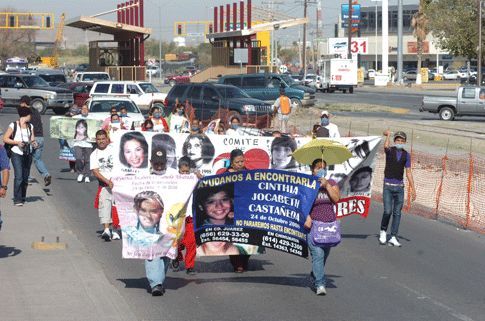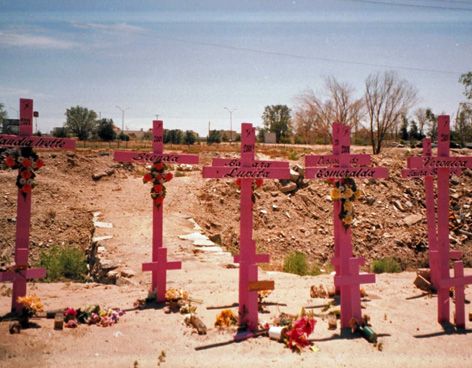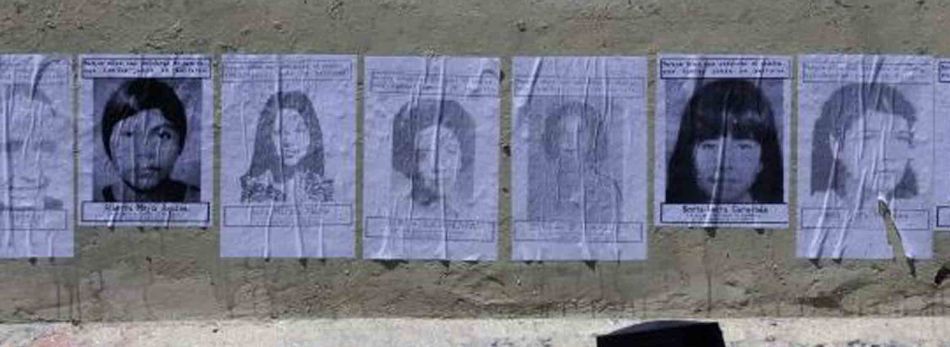
Publisher:
Bonnie King
CONTACT:
Newsroom@Salem-news.com
Advertising:
Adsales@Salem-news.com

~Truth~
~Justice~
~Peace~
TJP
Nov-25-2013 19:56

 TweetFollow @OregonNews
TweetFollow @OregonNews
FNS Feature: The Waitress Who Shook New Mexico
Kent Paterson for Salem-News.comIn all the instances, organized criminal activities and suspected political corruption were the backdrop to violence against women.
 Salem-News.com |
(LAS CRUCES , NM) - Editor’s Note: In commemoration of November 25, the International Day for the Elimination of Violence against Women, and December 10, International Human Rights Day, Frontera NorteSur will run a series of articles that discuss historical and contemporary dimensions of gender violence in New Mexico and the Paso del Norte borderland.

Today’s article looks at the still-unsolved death of a young Las Cruces woman who unwittingly became the center of a political and law enforcement upheaval that shaped the history of modern New Mexico. This story was made possible in part by a grant from the New Mexico Humanities Council.
At 83, Gerald Smith still vividly recalls that Saturday right before Easter Sunday back in 1949 when he and his friends went rabbit hunting on a whim outside Las Cruces, New Mexico.
“It’s hard to understand the spontaneity of teenagers,” Smith reflected, while reminiscing inside his country home in the pecan-shaded Mesilla Valley of southern New Mexico.
Hunting near the village of Mesquite, Smith was the first in his group to see her. Gazing on the ground, the 19-year-old beheld a black pile of “putrid flesh, pretty decomposed” but still clothed and sporting painted fingernails and toe nails. And there was the smell, an “odor you’ll never forget.”

Smith and company had stumbled across the body of Ovida “Cricket” Coogler, an 18-year old Las Cruces waitress who had been missing for weeks. The discovery of Coogler’s remains was something akin to pushing down the plunger on a pile of political dynamite.
Coogler’s suspected murder sparked grand jury investigations, the attempted frame-up of scapegoats, the imprisonments of three New Mexico lawmen, the disruption of organized crime activities in New Mexico, and the defeat of the Democrats in the 1950 gubernatorial election. It also produced one of the most enduring mysteries in New Mexico history.
More than just a crime story, the Cricket Coogler saga is about traditional and changing social mores and norms, political ethics and corruption, systems of justice, issues of race and social class, and the nature of gender relationships
So, just who was Cricket Coolger, and why was she so important? Las Cruces author Paula Moore is one person who has spent a lot of time digging into the Coogler story.

A petite young woman with a knack for attracting regulars to her jobs in Las Cruces diners and watering holes, Coogler was a 14-year-old school drop-out who went to work after her father’s death left the family in a financial lurch. “She was very well known in town, in a town where everybody knew everybody,” Moore said in an interview.
Reputedly called Cricket either because of her shoes or her chipper personality, the teenager began “dating” Santa Fe politicians who came into town with interesting regularity, hobnobbed with the local sheriff and other cops, and pursued many relationships with different and older men.
Known as a “party girl”, reports of physical abuse and even sado-masochistic sex accompanied her life. At times, the frequent partying of Coogler and associates would spill over into neighboring El Paso and Ciudad Juarez.
In her 2008 non-fiction book on Coogler, Moore characterized the young woman as “vivacious, outgoing, confident, but also moody and uppity.”
Dr. Quintin Ford, 90, is likely among the few living persons who remember Coogler. Ford, a former dean of mechanical engineering at New Mexico State University, was a student at the Las Cruces college back in 1946 when he was studying one evening in the make-shift dorm room he shared with a roommate.
Suddenly, “somebody knocked on the window,” Ford recalled.
To their surprise, the two roommates saw a barefooted stranger, a “disheveled young lady who obviously had been mistreated,” in the words of Ford. The unexpected guest then asked Ford and his friend for a lift into “town,” which in the Las Cruces of the time meant a ride along farms fields that stretched from the college into the downtown district.
Interviewed at his Las Cruces home this year, Ford said the woman he later learned was Cricket Coogler declined an offer to go to the police and instead asked to be taken to a bar where she said a change of clothes awaited. Complying with the request, Ford and friend dropped Coogler off before returning home to talk about their encounter.
“You have to realize we were both veterans and we’d been around quite a bit and had a pretty good understanding, I think, of life at that time,” Ford said. “And it was quite obvious what her profession was. She didn’t directly solicit but she made it rather apparent that she was available.”
Ford never met up again with the evening wanderer, but later recalled seeing newspaper stories about Coogler when he was living out-of-state a few years later. By then, the waitress had made history.
Early on the morning of March 31, 1949, Coogler vanished. Various and contradictory accounts place her getting into different cars in downtown Las Cruces, including being forcibly thrown into a state police vehicle, but nothing definitive was ever established.
In her book , Paula Moore meticulously retraces Coogler’s last evening and the possible culprits in her death. Multiple suspects emerged but “none seemed to check out,” Moore said. A full week passed before Dona Ana County Sheriff Alfonso Luchini Apodaca, popularly known as “Happy,” even publicized the disappearance of a woman he knew.
Cricket Coogler’s Las Cruces differed from the conservative, quiet image the city acquired in later years. Moore describes the City of Crosses as a place in transition where a dozen bars and all-night cafes made for a boisterous and sometimes rowdy downtown scene, even on week nights.
“Within a short distance were other lounges, including some in the adjacent, older village of Mesilla, where one who drank too much might be thrown out a hundred-year-old building,” Moore wrote. In the years after World War Two, Las Cruces was changing from the commercial center of a largely agricultural region. As the Cold War gathered steam, White Sands Missile Range expanded in the desert outside town. A boom of college students, older than usual and having the experiences of war under their belt, crammed the local university, as the G.I. Bill Generation came into its own. The name change from New Mexico College of Agriculture and Mechanic Arts to New Mexico State University symbolized the changes sweeping Las Cruces and New Mexico.
According to Moore, World War Two had profound effects on the social psyche and comportment of the citizenry.
 |
“The war had hammered home how precious life was, how final death was,” she wrote. “Rules of all kind loosened. Ordinary townspeople found themselves caught up in the lax atmosphere and convenient access to alcohol, gambling, and sex.”
The Las Cruces area’s proximity to Texas and the Mexican border state of Chihuahua made it a magnet for the gambling mafias that began flocking to the region from other parts of the U.S.
“In 1949, this stretch of southern New Mexico developed an atmosphere of ‘anything goes,’ especially if one had the protection of friends in law enforcement,” Moore penned.
Happy Apodaca was a central figure in the Coogler story. A native of the Hatch Valley north of Las Cruces, Apodaca had statewide professional and political connections thanks to his former job as a New Mexico state policeman.
 |
“He was a very interesting, colorful character,” Moore said of Apodaca. “Anyone who has ever met him still has a story about Happy Apodaca. I guess you can call him arrogant, funny. A lot of people said he was a good friend and others told their daughters, ‘Never get alone in a car with Happy Apodaca.’”
Called out by Gerald Smith’s friends to the Mesquite dumping ground of Cricket Coogler’s body, Apodaca arrived with deputies. In Smith’s recollection, what transpired next wasn’t exactly a scene from a “CSI” episode.
“Well, what I remember is (Apodaca) went over and lifted up her skirt and he said, ‘Yeah, that’s her.’” The sheriff, Smith continued, did not rope off the crime scene and may have even ran over some vehicle tracks, according to Smith’s brother, who was also present. “He felt that Happy Apodaca was destroying evidence. I can’t say he was or wasn’t.”
Smith said an ambulance driver did not want to put the human remains in “his clean ambulance, but the sheriff made him do it, cause it would really stink up the ambulance, you know.”
Next act, the condition of Coogler’s corpse plus irregularities in what passed for an autopsy made it impossible to precisely determine what killed the young woman, though signs of extreme violence protruded from the remains. In her book, Moore noted that Coogler’s panties, shoes, stockings and suit jacket were all missing when she was found dead.
Happy Apodaca’s actions after the recovery of Coogler’s remains landed him in hot water. Two men, widely considered scapegoats, were picked up and held in virtual isolation in the local hoosegow. One of the prisoners, New Mexico A&M student Jerry Nuzum was playing for the Pittsburgh Steelers and back in town to finish his studies for the off-season. Nuzum was one of many men who had contact with Coogler the night of her disappearance, but claimed any innocence in her disappearance and death. The football player’s jailing roused fellow students at the Las Cruces college to petition for his freedom.
The second jailed suspect, African-American World War Two veteran, Wesley Byrd, was tortured by police in a bid to extract a false confession. According to Moore, Sheriff Apodaca and state police officers drove Byrd to the Mesquite grave site of Cricket Coogler and threatened the man. A bicycle lock was fastened to Byrd’s testicles and the prisoner forced to walk, the Las Cruces writer said.
“It was very hot, very painful to do that,” Moore added. “And I think they threatened to bury him at that same spot if he didn’t confess, but he would not.”
In myriad ways, the unfolding Coogler drama read like a script for the official handling of the Ciudad Juarez and Chihuahua City women’s murders across the border more than four decades later.
The slowness in investigating disappearances, the mishandled evidence, the missing clothing, the botched autopsies, and the tortures of scapegoats, all crop up in Las Cruces, Ciudad Juarez and Chihuahua City. In all the instances, organized criminal activities and suspected political corruption were the backdrop to violence against women.
To be continued…..
-Kent Paterson
Frontera NorteSur: on-line, U.S.-Mexico border news Center for Latin American and Border Studies New Mexico State University Las Cruces, New Mexico
 |
 |
 |
Articles for November 24, 2013 | Articles for November 25, 2013 | Articles for November 26, 2013

Quick Links
DINING
Willamette UniversityGoudy Commons Cafe
Dine on the Queen
Willamette Queen Sternwheeler
MUST SEE SALEM
Oregon Capitol ToursCapitol History Gateway
Willamette River Ride
Willamette Queen Sternwheeler
Historic Home Tours:
Deepwood Museum
The Bush House
Gaiety Hollow Garden
AUCTIONS - APPRAISALS
Auction Masters & AppraisalsCONSTRUCTION SERVICES
Roofing and ContractingSheridan, Ore.
ONLINE SHOPPING
Special Occasion DressesAdvertise with Salem-News
Contact:AdSales@Salem-News.com


Salem-News.com:

Terms of Service | Privacy Policy
All comments and messages are approved by people and self promotional links or unacceptable comments are denied.
[Return to Top]
©2025 Salem-News.com. All opinions expressed in this article are those of the author and do not necessarily reflect those of Salem-News.com.